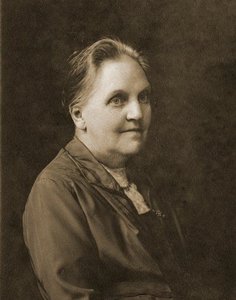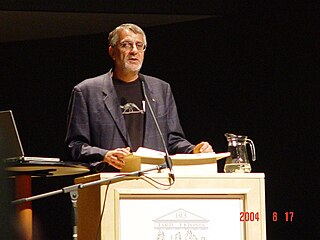Related Research Articles

Annie Lorrain Smith was a British lichenologist whose Lichens (1921) was an essential textbook for several decades. She was also a mycologist and founder member of the British Mycological Society, where she served as president for two terms.

Micarea is a genus of lichenized fungi in the family Pilocarpaceae. The widely distributed genus contains 126 species and new species are described actively. Species in the genus are crustose lichens and their photobiont is a single-celled green alga.
David Leslie Hawksworth is a British mycologist and lichenologist currently with a professorship in the Universidad Complutense de Madrid in Madrid, Spain and also a Scientific Associate of The Natural History Museum in London. In 2002, he was honoured with an Acharius Medal by the International Association for Lichenology. He married Patricia Wiltshire, a leading forensic ecologist and palynologist in 2009. As of 2022, he is the Editor-in-Chief of the journals IMA Fungus and Biodiversity and Conservation.
Celtic Rainforest is a colloquial term which refers to the temperate rainforest of Ireland and Great Britain. These woodlands are also variously referred to as Atlantic rainforest, Upland Oakwoods, Atlantic Oakwoods or Western Oakwoods. Today, the Celtic Rainforest exists as small fragments of the temperate rainforest that once covered much of Ireland and the west coast of Great Britain. The majority of these fragments occur on steep-sided slopes above rivers and lakes which have avoided clearance and intensive grazing pressure. There are notable examples in Ireland especially along its western coast, including the Beara Rainforest in West Cork, the Great Forest of Aughty in Clare and Galway, Oldhead Wood in Mayo and Ardnamona Wood and Glenveagh in Donegal. In Scotland, rainforest exists on the islands and shores of Loch Maree, Loch Sunart, Loch Lomond, and one of the best preserved sites on the remote Taynish Peninsula in Argyll. In Wales, they occur on steep-sided riverine gorges in Snowdonia and Mid Wales. In England, there are examples in the Lake District, and steep-sided riverine and estuarine valleys in South West England, including the Fowey valley in Cornwall, and the valley of the river Dart which flows off Dartmoor, and has rainfall in excess of 2 metres per year.
The International Association for Lichenology (IAL) is an organisation that encourages the understanding of lichens and lichenology, and promotes their study and conservation worldwide. It unites lichenologists across the globe, as well as national and regional organisations into one group. It is affiliated to the International Union of Biological Sciences (IUBS). The IAL organises field courses and excursions, as well as symposia which are the biggest events in lichenology on the international level. The 8th International Symposium will be held in Helsinki, Finland, in August 2016.
Peter Wilfred James (1930–2014) was an English botanist and lichenologist. He was a pioneer in the study of lichens as environmental indicators, especially of atmospheric pollution.

David John Galloway, FRSNZ was a biochemist, botanist, and lichenologist.
Per Magnus Jørgensen is a Norwegian botanist and lichenologist, and Professor Emeritus of systematic botany at the University of Bergen. He is known for his work on the lichen families Pannariaceae and Collemataceae. Jørgensen was awarded the Acharius Medal in 2021 for his lifetime contributions to lichenology.
Brian John Coppins is a botanist and lichenologist, considered a world authority on crustose lichens and a leading expert on the genus Micarea.
Peter Crittenden is a British lichenologist. His research largely concerns the ecophysiology of lichens. Crittenden is known for using new techniques to study lichens, such as the use of 3D printing and X-ray computed tomography to study lichen structure and development. He served as the senior editor of the scientific journal The Lichenologist from the years 2000–2016; and still serves on the editorial board for the journal Fungal Ecology. Crittenden was the president of the British Lichen Society in 1998–1999, and president of the International Association for Lichenology from 2008 to 2012. He was awarded the Acharius Medal at the 10th International Mycological Congress in Bangkok in 2014, for his lifetime achievements in lichenology.

Catillaria is a genus of crustose lichens in the family Catillariaceae. The genus was circumscribed by Italian lichenologist Abramo Bartolommeo Massalongo in 1852. It is the type genus of Catillariaceae, which was circumscribed by Austrian lichenologist Josef Hafellner in 1984.
Natsurang Homchantara was a Thai lichenologist. In her relatively short career, she specialised in the taxonomy of the family Thelotremataceae, in which she helped describe many new species.
Henricus (Harrie) Johannes Maria Sipman is a Dutch lichenologist. He specialises in tropical and subtropical lichens, and has authored or co-authored more than 250 scientific publications. He was the curator of the lichen herbarium at the Berlin Botanical Garden and Botanical Museum from 1983 until his retirement in 2010.
The British Lichen Society (BLS) was founded in 1958 with the objective of promoting the study and conservation of lichen. Although the society was founded in London, UK, it is also of relevance to lichens worldwide. It has been a registered charity since 1964.
Mark Richard David Seaward is a British ecologist and lichenologist. He was awarded the Acharius Medal in 2006 for lifetime contributions to lichenology.

Pier Luigi Nimis is a senior professor of botany at the University of Trieste in Italy. He specialises in lichenology and phytogeography, including the uses of lichens as indicators of pollution and devising methods for web-based identification keys.
Rebecca Yahr is an American lichenologist who works at the Royal Botanic Garden Edinburgh in Scotland. She was President of the British Lichen Society from 2019 until 2022.
Oliver Gilbert was an urban ecologist and lichenologist. He was a reader in landscape ecology at Sheffield University. He was one of the early users of lichens as indicators of air pollution, and also studied the ecology and diversity of wildlife in urban areas.
Catillaria gilbertii is a rare species of saxicolous (rock-dwelling), crustose lichen in the family Catillariaceae. It is found in the Central Highlands of Scotland.
Alan Orange was a British lichenologist. His research interests included lichen taxonomy and phylogenetics, aquatic lichens, and the family Verrucariaceae.
References
- 1 2 3 "Double celebration for Sandy and Brian: Brian and Sandy Coppins have been awarded two top accolades for their research and conservation work". Edinburgh News. 13 December 2016.
- ↑ Crittenden, Peter. "Brian J. Coppins, Acharius Medallists". International Association for Lichenology (lichenology.org).
- ↑ Coppins, A M; Coppins, B J (2010). Atlantic hazel (PDF). Scottish Natural Heritage.
- ↑ Harvey, Ellie. "Growing in Plain Sight: Women in the British Lichen Society Archives". RBGE Botanics Stories. Retrieved 13 January 2024.
- ↑ "BLS Officers". British Lichen Society. Retrieved 24 August 2022.
- ↑ Fryday, Alan; Kantvilas, Gintaras; Ellis, Christopher; Crittenden, Peter (2014). "Brian Coppins – A liber amicorum". The Lichenologist. 46 (3): 245–246. doi: 10.1017/S0024282914000061 . ISSN 0024-2829.